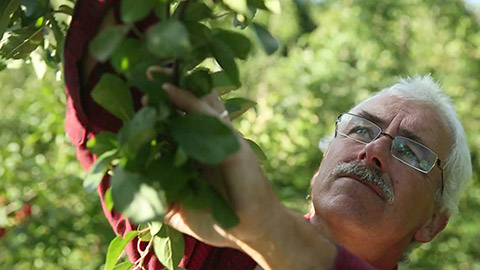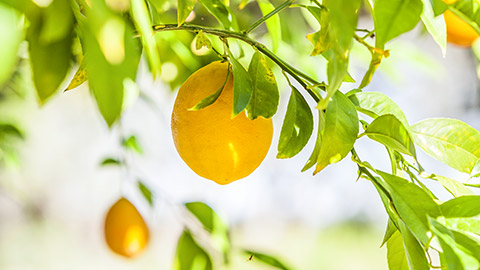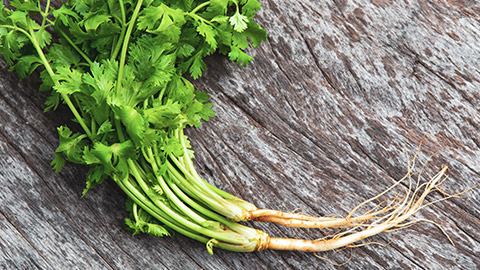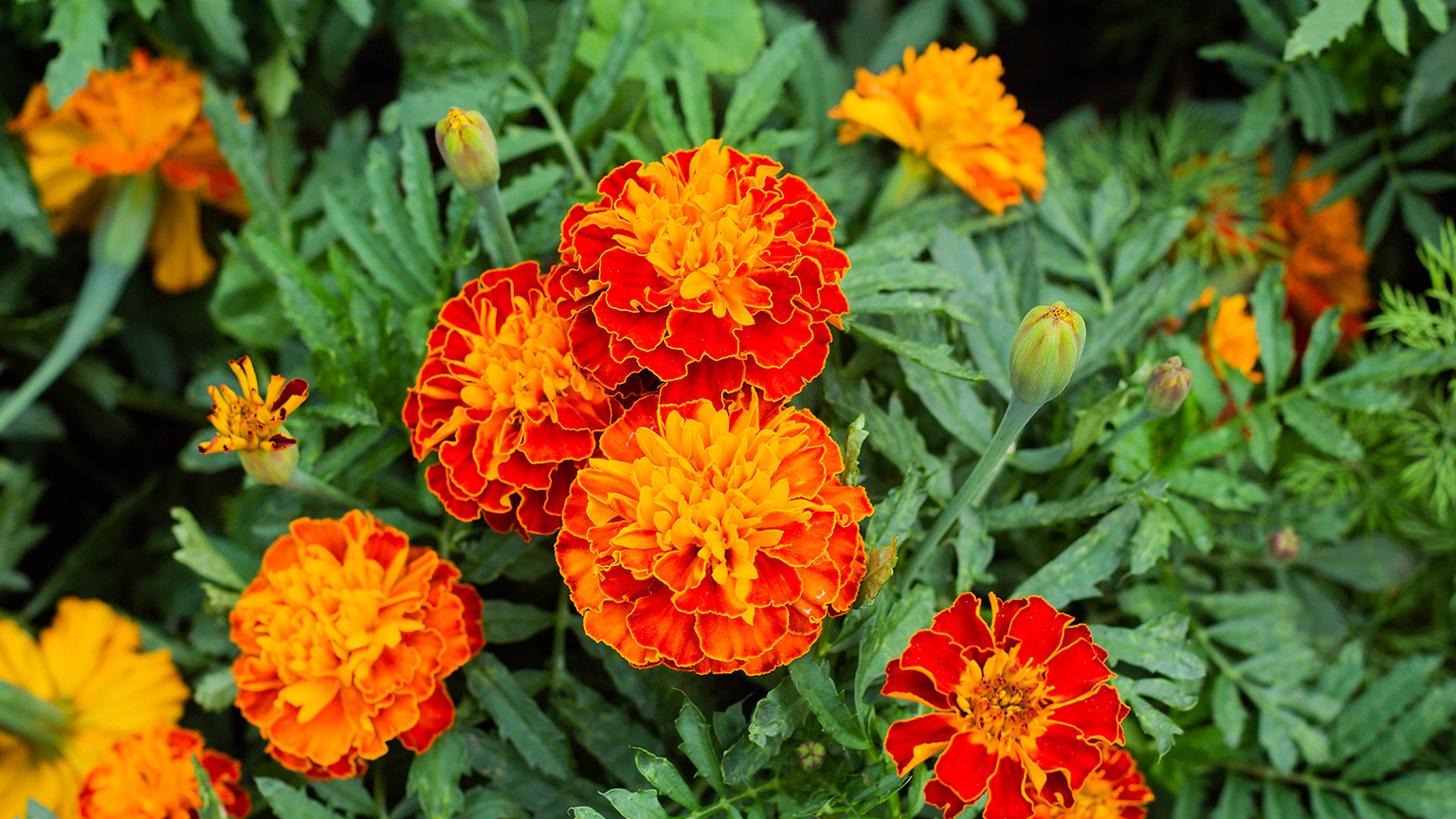African marigold (Tagetes erecta) is a superhero in the garden. Once established, it's hardy, attracts pollinators, and resists some pests. Many growers plant it to help crops in a natural way.
There are plenty of reasons why you'd plant a particular plant, and for each reason there will be specific plant features that you want.
For a shade tree, you might want a tree that grows fast, and has a large spread and dense foliage. You might decide that it should be deciduous, because, in winter you want the sun to reach that part of the garden, or you might opt for an evergreen tree, so the area stays shady year-round.
You might want it to offer other benefits, like producing flowers that attract birds and insects or producing fruit for you to eat.
A plant can also be desirable where its growth needs match the site conditions. In this topic we'll talk about both benefits and environmental conditions.
As mentioned above, plants are grown for a wide variety of reasons and to benefit a wide range of people, animals, and even other plants.
Plants offer many benefits
When thinking about whether a plant is desirable or not, consider these things; plants can:
- provide shelter from the sun
- absorb carbon dioxide and produce oxygen
- cool the air around them
- break up heavy rain to give it time to infiltrate the soil rather than run off
- remove contaminants from water
- reduce noise
- provide habitats for birds, bats, frogs, lizards, and insects
- encourage other plants to grow (companion planting)
- screen/block undesirable views
- give off nice smells
- attract pollinators
- provide nutrients for the soil
- provide food for humans and other animals
- be used for play (e.g., a treehouse in a tree, a swing from a branch, a secret hideout formed by peas growing up bamboo stakes, or grass to play a game of football on).
And I'm sure you can think of more!
Sometimes it's easy to say "this doesn't produce food or flowers, so it's not worth having" but this is an oversimplification, as the list above shows.
What growers want
When it comes to crops, growers want plant species that "fit" with their production system, such as:
- The growing period: How many crop rotations can we fit within the growing season? If only one, can we utilise the space for other crops within the growing season?
- Harvesting: How easy is it to harvest the edible/usable parts of the plant? Can the plant be pruned or trained to make it easier to harvest without negatively affecting plant health?
- Storage: How well does the edible/usable part of the plant store? Does it bench ripen?
- Pest and disease resistance: How resistant is this plant to diseases? Pest-resistant cultivars aren't very common, but would growing an entirely different crop species be a realistic alternative?
In addition to their crops, they might want other plants around that make the site more pleasant to work at – such as shade and shelter trees – and support pollination and biodiversity – such as flowering trees, shrubs, and annuals.
▶ Permaculture Orchard: Beyond Organic (optional additional video resource)
Watch the following video sections from the Permaculture Orchard: Beyond Organic, where Stefan Sobkowiak talks about the three distinct layers of desirable plants grown in the permaculture orchard, and some of the benefits they offer.
Stefan's example of controlling "southwest injury" by planting shrubs around the fruit trees is an example of a beneficial relationship between plants.

| Timestamp 1 | The tree layer | 0:13:09-0:15:07 |
| Timestamp 2 | The shrub layer | 1:03:46-1:05:28 |
| Timestamp 3 | Perennials and groundcovers | 1:09:17-1:12:05 |
What consumers want

Meyer lemons (Citrus x meyeri) are a popular choice for Kiwi gardeners because of their taste and hardiness.
And we can't forget that if we're growing plants for consumers, we need to consider what they want. If we're growing edible crops, the features most important to consumers are most likely to be:
- Taste: If the produce doesn't taste good, consumers won't buy it. At least, they won't keep buying it.
- Value: This programme is not about running a horticulture business, so we're not considering the dollar value of the crop, but rather the perception of value. Like when you buy an avocado and find that most of the fruit is taken up by the stone. We would perceive this as not good value.
- Cosmetic: Cosmetic factors like the size, shape, and colour of the produce. Usually, these expectations are related to what people see at the grocery store.
- If you're selling directly to consumers, you may be able to convince them that an ugly looking fruit is worth buying if it tastes delicious by offering samples, but if your produce is going to be judged on its appearance, consider these when choosing your plants.
- Additionally, consumers are often interested to try unique produce, including heirloom species like black tomatoes, rainbow silverbeet and purple cauliflower. These can often be sold for a higher price, provided they also taste great.

The other thing to consider is that plants can be desirable, or undesirable based on how well they cope with the growing conditions of the site.
To recap what we're already covered, let's consider some questions that may help us decide it a plant species is desirable for a chosen site:
- Light: Does it tolerate or prefer full sun, partial shade, full shade?
- Wind: Does it tolerate exposed (windy) locations, or does it need to be sheltered from the wind?
- Frost: Is it frost tender or frost hardy?
- Soil type: Does it prefer sandy soil, clay or organic soil?
- Soil drainage: Does it like to have "dry feel" (well-drained soil) or does it prefer moist or moisture-retentive soils?
- Soil pH: Does it prefer acidic, alkaline or neutral soil pH?
Additionally, where appropriate, consider:
- Water and nutrient demands: Some plants require lots of water and/or nutrients. Those that require large amounts of nutrients are said to be gross feeders. How is the site and growing system able to provide the water and nutrient requirements of the plant?
- Costal tolerance: For sites near the sea, how well does the plant species tolerate costal conditions/salt spray?
How do these growing preferences and tolerances align with the site conditions?

Many people don't like the taste of coriander (Coriandrum sativum) aka cilantro. For some, it tastes like soap due to a genetic variation in our taste buds. It's also not very easy to grow in many places in New Zealand. But for others, it's worth all the effort because the flavour is strong and unique.
If you're about to start growing new plants – whether you're buying them or propagating them yourself, it makes sense to take the time to find the most appropriate (desirable) plants.
This involves working out who needs to benefit from the plants and what features they want as a result.
Then it's a case of doing the research, either by talking to experienced gardeners or horticulturalists, or by using online tools. When you find a plant species that seems to meet your needs, consider other similar plants and whether they may be more suitable. For instance, try searching "disease resistant eating apple nz". You might find that you're better off choosing to grow Monty's Surprise than Blenheim Orange (apple).
In your Plant Suitability Report (Assessment 1), you'll be asked to consider alternatives to the plants already being grown.
